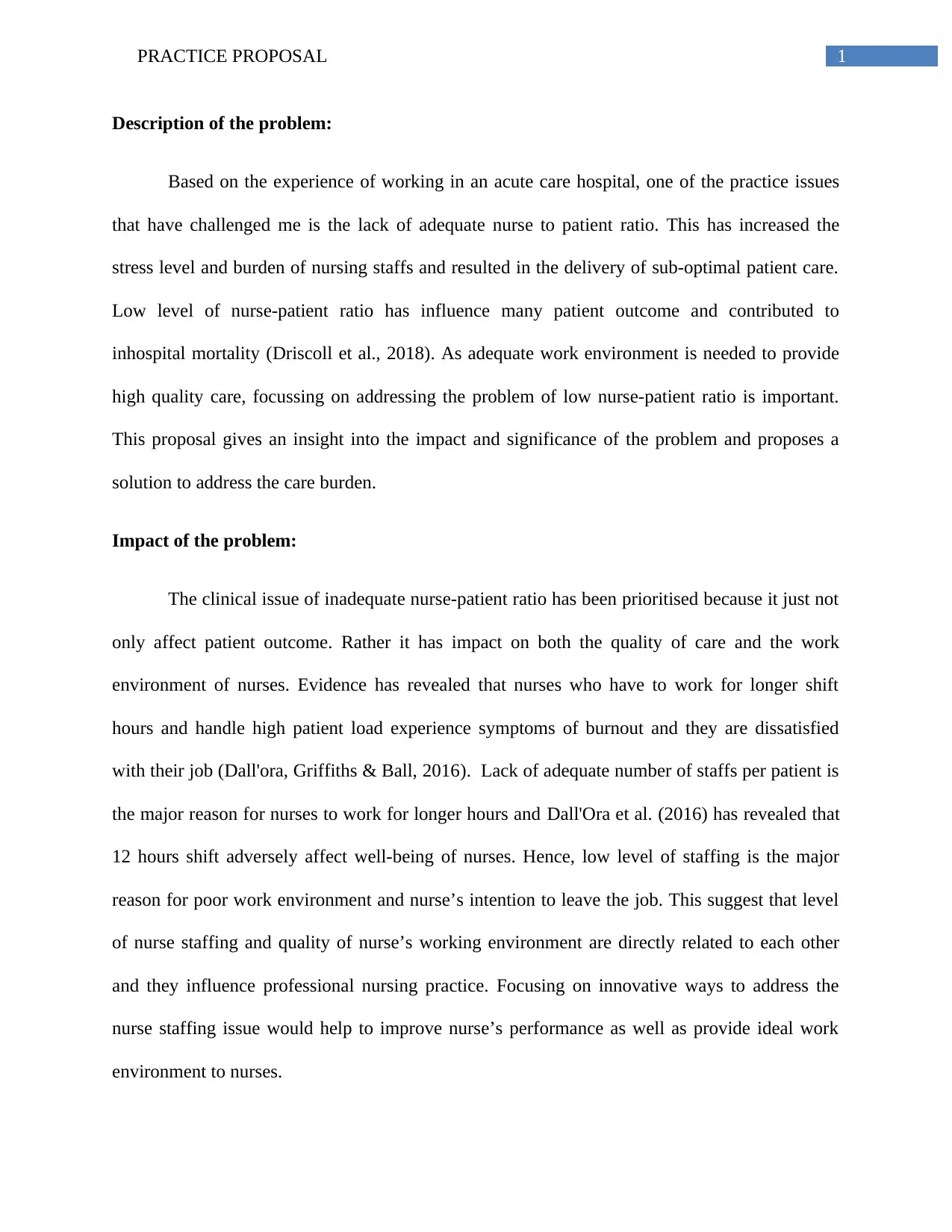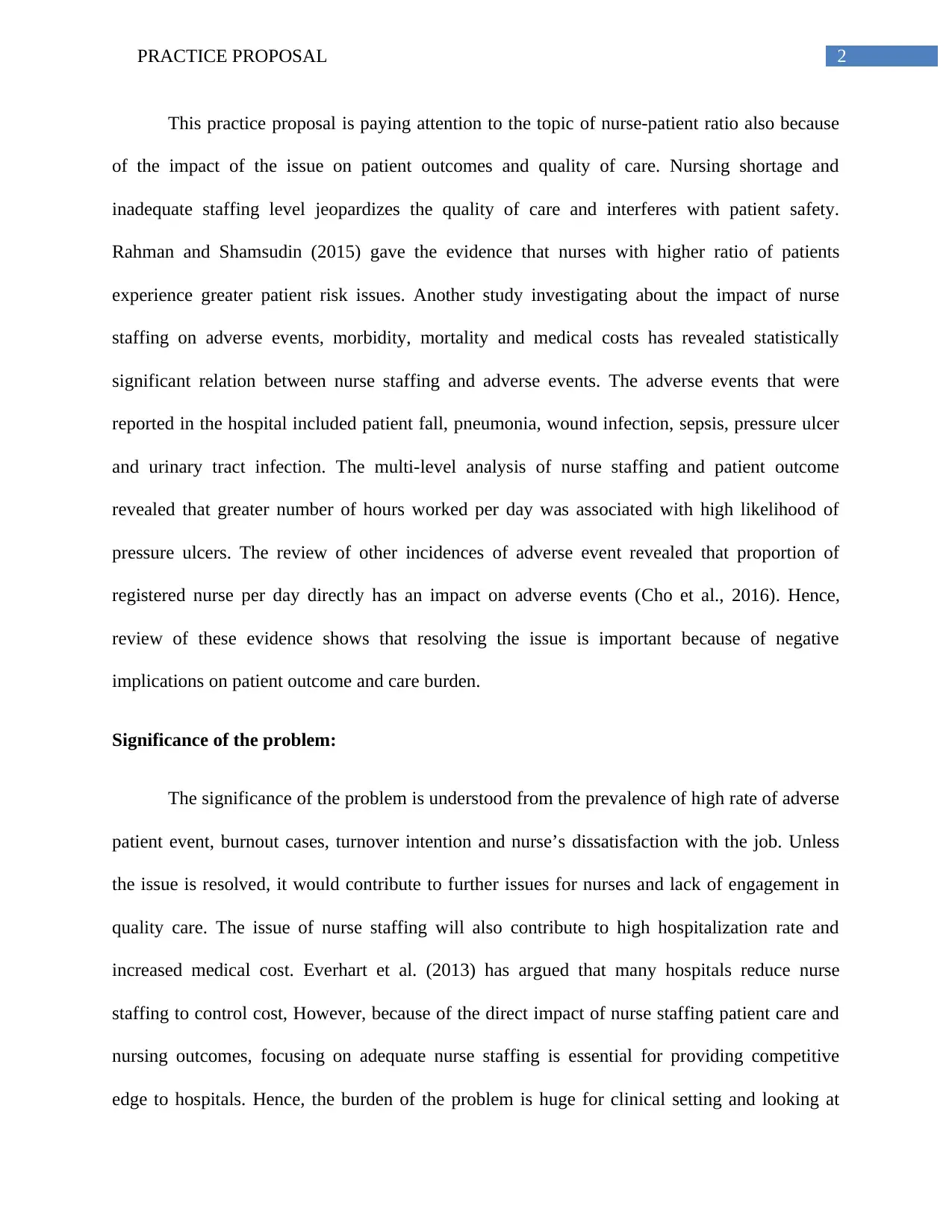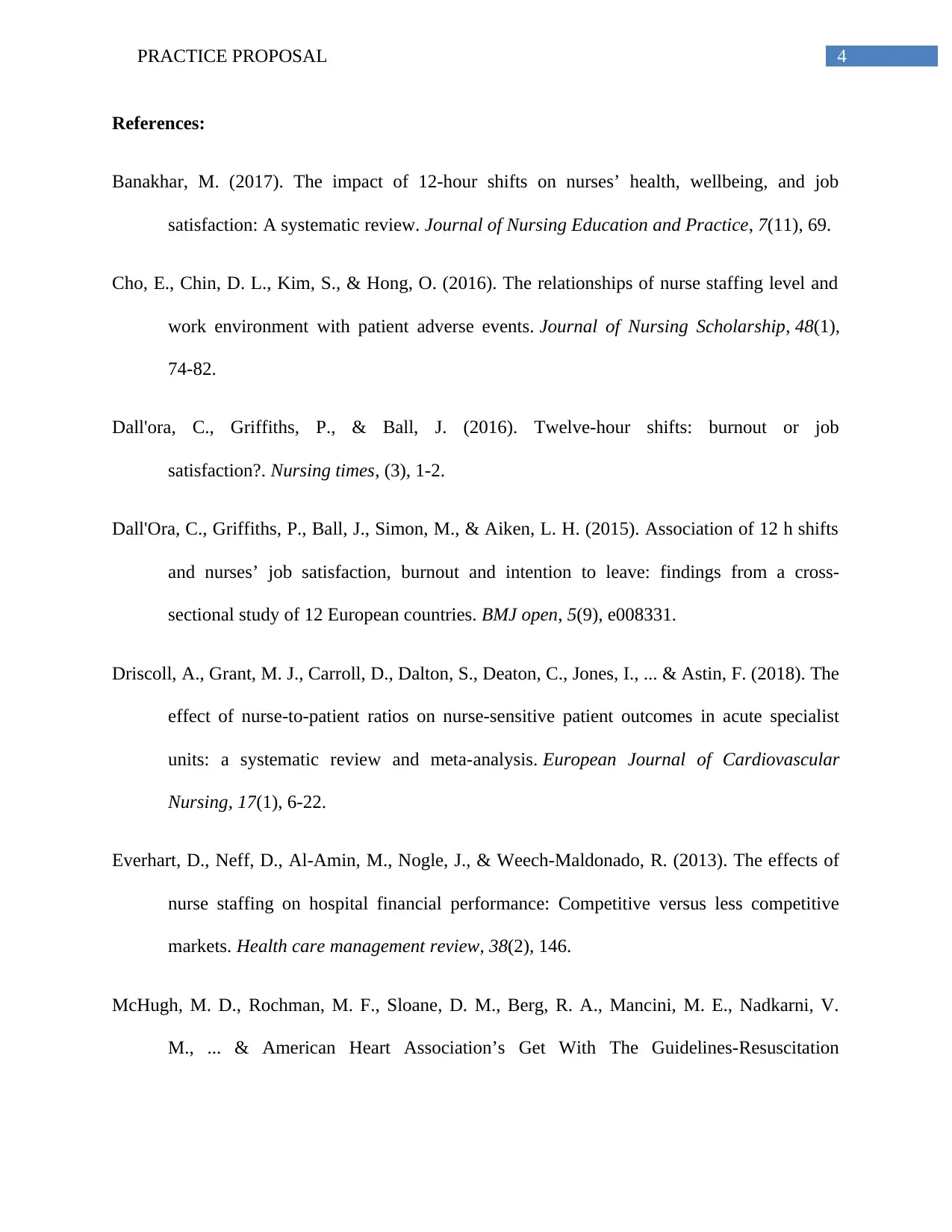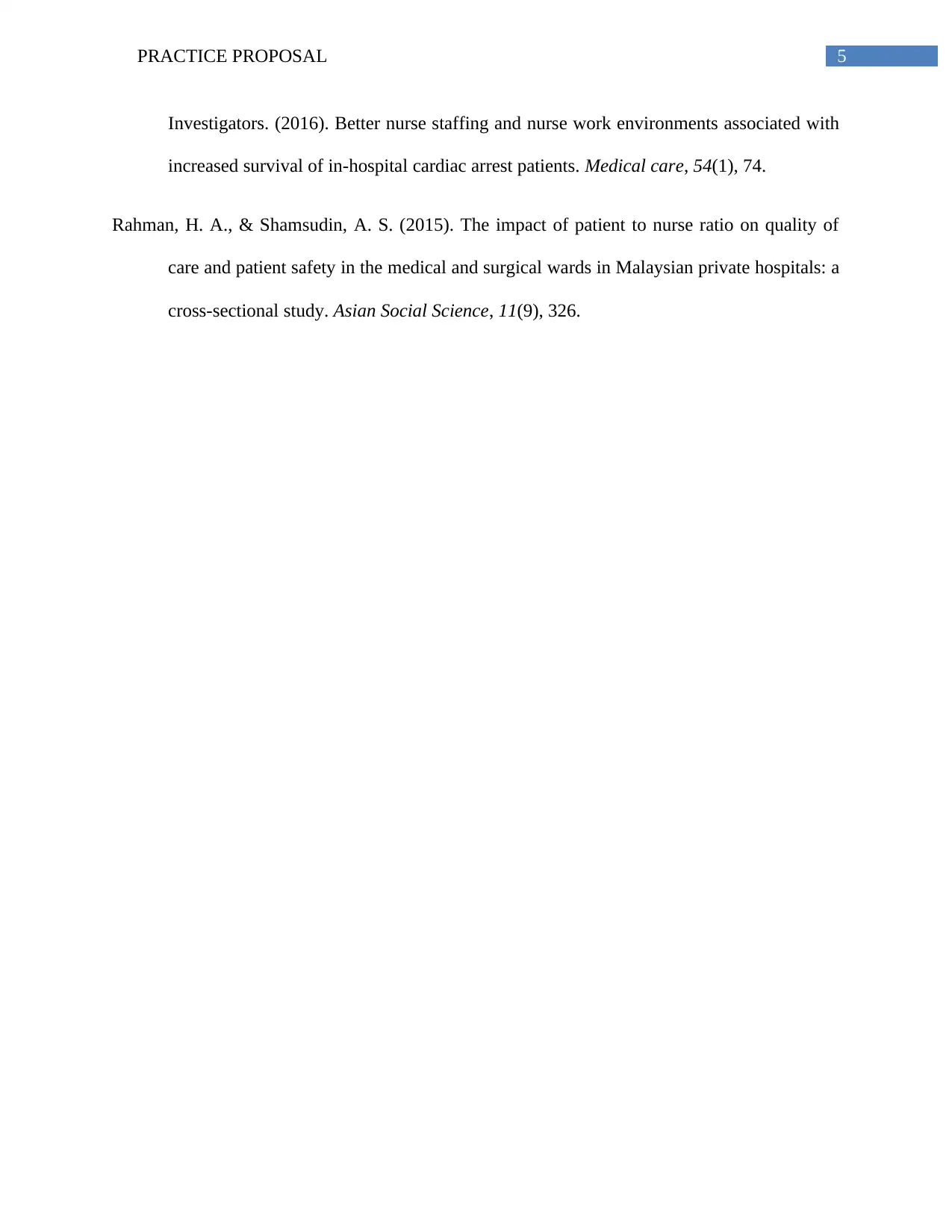Practice Proposal
VerifiedAdded on 2023/04/20
|6
|1333
|93
AI Summary
This practice proposal addresses the issue of low nurse to patient ratio in acute care hospitals and proposes a solution to improve patient outcomes and nurse satisfaction.
Contribute Materials
Your contribution can guide someone’s learning journey. Share your
documents today.

Running head: PRACTICE PROPOSAL
Practice proposal
Name of the student:
Name of the University:
Author’s note
Practice proposal
Name of the student:
Name of the University:
Author’s note
Secure Best Marks with AI Grader
Need help grading? Try our AI Grader for instant feedback on your assignments.

1PRACTICE PROPOSAL
Description of the problem:
Based on the experience of working in an acute care hospital, one of the practice issues
that have challenged me is the lack of adequate nurse to patient ratio. This has increased the
stress level and burden of nursing staffs and resulted in the delivery of sub-optimal patient care.
Low level of nurse-patient ratio has influence many patient outcome and contributed to
inhospital mortality (Driscoll et al., 2018). As adequate work environment is needed to provide
high quality care, focussing on addressing the problem of low nurse-patient ratio is important.
This proposal gives an insight into the impact and significance of the problem and proposes a
solution to address the care burden.
Impact of the problem:
The clinical issue of inadequate nurse-patient ratio has been prioritised because it just not
only affect patient outcome. Rather it has impact on both the quality of care and the work
environment of nurses. Evidence has revealed that nurses who have to work for longer shift
hours and handle high patient load experience symptoms of burnout and they are dissatisfied
with their job (Dall'ora, Griffiths & Ball, 2016). Lack of adequate number of staffs per patient is
the major reason for nurses to work for longer hours and Dall'Ora et al. (2016) has revealed that
12 hours shift adversely affect well-being of nurses. Hence, low level of staffing is the major
reason for poor work environment and nurse’s intention to leave the job. This suggest that level
of nurse staffing and quality of nurse’s working environment are directly related to each other
and they influence professional nursing practice. Focusing on innovative ways to address the
nurse staffing issue would help to improve nurse’s performance as well as provide ideal work
environment to nurses.
Description of the problem:
Based on the experience of working in an acute care hospital, one of the practice issues
that have challenged me is the lack of adequate nurse to patient ratio. This has increased the
stress level and burden of nursing staffs and resulted in the delivery of sub-optimal patient care.
Low level of nurse-patient ratio has influence many patient outcome and contributed to
inhospital mortality (Driscoll et al., 2018). As adequate work environment is needed to provide
high quality care, focussing on addressing the problem of low nurse-patient ratio is important.
This proposal gives an insight into the impact and significance of the problem and proposes a
solution to address the care burden.
Impact of the problem:
The clinical issue of inadequate nurse-patient ratio has been prioritised because it just not
only affect patient outcome. Rather it has impact on both the quality of care and the work
environment of nurses. Evidence has revealed that nurses who have to work for longer shift
hours and handle high patient load experience symptoms of burnout and they are dissatisfied
with their job (Dall'ora, Griffiths & Ball, 2016). Lack of adequate number of staffs per patient is
the major reason for nurses to work for longer hours and Dall'Ora et al. (2016) has revealed that
12 hours shift adversely affect well-being of nurses. Hence, low level of staffing is the major
reason for poor work environment and nurse’s intention to leave the job. This suggest that level
of nurse staffing and quality of nurse’s working environment are directly related to each other
and they influence professional nursing practice. Focusing on innovative ways to address the
nurse staffing issue would help to improve nurse’s performance as well as provide ideal work
environment to nurses.

2PRACTICE PROPOSAL
This practice proposal is paying attention to the topic of nurse-patient ratio also because
of the impact of the issue on patient outcomes and quality of care. Nursing shortage and
inadequate staffing level jeopardizes the quality of care and interferes with patient safety.
Rahman and Shamsudin (2015) gave the evidence that nurses with higher ratio of patients
experience greater patient risk issues. Another study investigating about the impact of nurse
staffing on adverse events, morbidity, mortality and medical costs has revealed statistically
significant relation between nurse staffing and adverse events. The adverse events that were
reported in the hospital included patient fall, pneumonia, wound infection, sepsis, pressure ulcer
and urinary tract infection. The multi-level analysis of nurse staffing and patient outcome
revealed that greater number of hours worked per day was associated with high likelihood of
pressure ulcers. The review of other incidences of adverse event revealed that proportion of
registered nurse per day directly has an impact on adverse events (Cho et al., 2016). Hence,
review of these evidence shows that resolving the issue is important because of negative
implications on patient outcome and care burden.
Significance of the problem:
The significance of the problem is understood from the prevalence of high rate of adverse
patient event, burnout cases, turnover intention and nurse’s dissatisfaction with the job. Unless
the issue is resolved, it would contribute to further issues for nurses and lack of engagement in
quality care. The issue of nurse staffing will also contribute to high hospitalization rate and
increased medical cost. Everhart et al. (2013) has argued that many hospitals reduce nurse
staffing to control cost, However, because of the direct impact of nurse staffing patient care and
nursing outcomes, focusing on adequate nurse staffing is essential for providing competitive
edge to hospitals. Hence, the burden of the problem is huge for clinical setting and looking at
This practice proposal is paying attention to the topic of nurse-patient ratio also because
of the impact of the issue on patient outcomes and quality of care. Nursing shortage and
inadequate staffing level jeopardizes the quality of care and interferes with patient safety.
Rahman and Shamsudin (2015) gave the evidence that nurses with higher ratio of patients
experience greater patient risk issues. Another study investigating about the impact of nurse
staffing on adverse events, morbidity, mortality and medical costs has revealed statistically
significant relation between nurse staffing and adverse events. The adverse events that were
reported in the hospital included patient fall, pneumonia, wound infection, sepsis, pressure ulcer
and urinary tract infection. The multi-level analysis of nurse staffing and patient outcome
revealed that greater number of hours worked per day was associated with high likelihood of
pressure ulcers. The review of other incidences of adverse event revealed that proportion of
registered nurse per day directly has an impact on adverse events (Cho et al., 2016). Hence,
review of these evidence shows that resolving the issue is important because of negative
implications on patient outcome and care burden.
Significance of the problem:
The significance of the problem is understood from the prevalence of high rate of adverse
patient event, burnout cases, turnover intention and nurse’s dissatisfaction with the job. Unless
the issue is resolved, it would contribute to further issues for nurses and lack of engagement in
quality care. The issue of nurse staffing will also contribute to high hospitalization rate and
increased medical cost. Everhart et al. (2013) has argued that many hospitals reduce nurse
staffing to control cost, However, because of the direct impact of nurse staffing patient care and
nursing outcomes, focusing on adequate nurse staffing is essential for providing competitive
edge to hospitals. Hence, the burden of the problem is huge for clinical setting and looking at

3PRACTICE PROPOSAL
innovative ways to resolve the issue would help in promoting well-being of professional nurses
as well as improving quality parameters in hospital setting.
Proposed solution to the problem:
In response to the issue of low nurse to patient ratio, one innovative solution that has
been proposed is to encourage hospitals to consider investing in nursing resources so that more
number of nurses are recruited and standard nurse to patient ratios are maintained. The
recruitment process and allocation of work shift process needs to be changed so that no nurses
are overburdened with task and everyone gets the opportunity for adequate breaks between work
too. Nurse leaders or managers need to engage in careful scheduling so that each nursing staff
get a more balance shift schedule and they do experience stress and burnout. Evidence by
Banakhar (2017) suggests that by engaging in careful scheduling, fatigues and poor work
performances among nurses can be avoided. Developing a flexible work schedule can also help
address nursing dissatisfaction with job and increase the likelihood of providing healthy work
environment to nursing staffs.
innovative ways to resolve the issue would help in promoting well-being of professional nurses
as well as improving quality parameters in hospital setting.
Proposed solution to the problem:
In response to the issue of low nurse to patient ratio, one innovative solution that has
been proposed is to encourage hospitals to consider investing in nursing resources so that more
number of nurses are recruited and standard nurse to patient ratios are maintained. The
recruitment process and allocation of work shift process needs to be changed so that no nurses
are overburdened with task and everyone gets the opportunity for adequate breaks between work
too. Nurse leaders or managers need to engage in careful scheduling so that each nursing staff
get a more balance shift schedule and they do experience stress and burnout. Evidence by
Banakhar (2017) suggests that by engaging in careful scheduling, fatigues and poor work
performances among nurses can be avoided. Developing a flexible work schedule can also help
address nursing dissatisfaction with job and increase the likelihood of providing healthy work
environment to nursing staffs.
Secure Best Marks with AI Grader
Need help grading? Try our AI Grader for instant feedback on your assignments.

4PRACTICE PROPOSAL
References:
Banakhar, M. (2017). The impact of 12-hour shifts on nurses’ health, wellbeing, and job
satisfaction: A systematic review. Journal of Nursing Education and Practice, 7(11), 69.
Cho, E., Chin, D. L., Kim, S., & Hong, O. (2016). The relationships of nurse staffing level and
work environment with patient adverse events. Journal of Nursing Scholarship, 48(1),
74-82.
Dall'ora, C., Griffiths, P., & Ball, J. (2016). Twelve-hour shifts: burnout or job
satisfaction?. Nursing times, (3), 1-2.
Dall'Ora, C., Griffiths, P., Ball, J., Simon, M., & Aiken, L. H. (2015). Association of 12 h shifts
and nurses’ job satisfaction, burnout and intention to leave: findings from a cross-
sectional study of 12 European countries. BMJ open, 5(9), e008331.
Driscoll, A., Grant, M. J., Carroll, D., Dalton, S., Deaton, C., Jones, I., ... & Astin, F. (2018). The
effect of nurse-to-patient ratios on nurse-sensitive patient outcomes in acute specialist
units: a systematic review and meta-analysis. European Journal of Cardiovascular
Nursing, 17(1), 6-22.
Everhart, D., Neff, D., Al-Amin, M., Nogle, J., & Weech-Maldonado, R. (2013). The effects of
nurse staffing on hospital financial performance: Competitive versus less competitive
markets. Health care management review, 38(2), 146.
McHugh, M. D., Rochman, M. F., Sloane, D. M., Berg, R. A., Mancini, M. E., Nadkarni, V.
M., ... & American Heart Association’s Get With The Guidelines-Resuscitation
References:
Banakhar, M. (2017). The impact of 12-hour shifts on nurses’ health, wellbeing, and job
satisfaction: A systematic review. Journal of Nursing Education and Practice, 7(11), 69.
Cho, E., Chin, D. L., Kim, S., & Hong, O. (2016). The relationships of nurse staffing level and
work environment with patient adverse events. Journal of Nursing Scholarship, 48(1),
74-82.
Dall'ora, C., Griffiths, P., & Ball, J. (2016). Twelve-hour shifts: burnout or job
satisfaction?. Nursing times, (3), 1-2.
Dall'Ora, C., Griffiths, P., Ball, J., Simon, M., & Aiken, L. H. (2015). Association of 12 h shifts
and nurses’ job satisfaction, burnout and intention to leave: findings from a cross-
sectional study of 12 European countries. BMJ open, 5(9), e008331.
Driscoll, A., Grant, M. J., Carroll, D., Dalton, S., Deaton, C., Jones, I., ... & Astin, F. (2018). The
effect of nurse-to-patient ratios on nurse-sensitive patient outcomes in acute specialist
units: a systematic review and meta-analysis. European Journal of Cardiovascular
Nursing, 17(1), 6-22.
Everhart, D., Neff, D., Al-Amin, M., Nogle, J., & Weech-Maldonado, R. (2013). The effects of
nurse staffing on hospital financial performance: Competitive versus less competitive
markets. Health care management review, 38(2), 146.
McHugh, M. D., Rochman, M. F., Sloane, D. M., Berg, R. A., Mancini, M. E., Nadkarni, V.
M., ... & American Heart Association’s Get With The Guidelines-Resuscitation

5PRACTICE PROPOSAL
Investigators. (2016). Better nurse staffing and nurse work environments associated with
increased survival of in-hospital cardiac arrest patients. Medical care, 54(1), 74.
Rahman, H. A., & Shamsudin, A. S. (2015). The impact of patient to nurse ratio on quality of
care and patient safety in the medical and surgical wards in Malaysian private hospitals: a
cross-sectional study. Asian Social Science, 11(9), 326.
Investigators. (2016). Better nurse staffing and nurse work environments associated with
increased survival of in-hospital cardiac arrest patients. Medical care, 54(1), 74.
Rahman, H. A., & Shamsudin, A. S. (2015). The impact of patient to nurse ratio on quality of
care and patient safety in the medical and surgical wards in Malaysian private hospitals: a
cross-sectional study. Asian Social Science, 11(9), 326.
1 out of 6
Related Documents
Your All-in-One AI-Powered Toolkit for Academic Success.
+13062052269
info@desklib.com
Available 24*7 on WhatsApp / Email
![[object Object]](/_next/static/media/star-bottom.7253800d.svg)
Unlock your academic potential
© 2024 | Zucol Services PVT LTD | All rights reserved.





